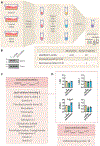Skeletal Muscle SIRT3 Deficiency Contributes to Pulmonary Vascular Remodeling in Pulmonary Hypertension Due to Heart Failure With Preserved Ejection Fraction
- PMID: 38804138
- PMCID: PMC11384544
- DOI: 10.1161/CIRCULATIONAHA.124.068624
Skeletal Muscle SIRT3 Deficiency Contributes to Pulmonary Vascular Remodeling in Pulmonary Hypertension Due to Heart Failure With Preserved Ejection Fraction
Abstract
Background: Pulmonary hypertension (PH) is a major complication linked to adverse outcomes in heart failure with preserved ejection fraction (HFpEF), yet no specific therapies exist for PH associated with HFpEF (PH-HFpEF). We have recently reported on the role of skeletal muscle SIRT3 (sirtuin-3) in modulation of PH-HFpEF, suggesting a novel endocrine signaling pathway for skeletal muscle modulation of pulmonary vascular remodeling.
Methods: Using skeletal muscle-specific Sirt3 knockout mice (Sirt3skm-/-) and mass spectrometry-based comparative secretome analysis, we attempted to define the processes by which skeletal muscle SIRT3 defects affect pulmonary vascular health in PH-HFpEF.
Results: Sirt3skm-/- mice exhibited reduced pulmonary vascular density accompanied by pulmonary vascular proliferative remodeling and elevated pulmonary pressures. Comparative analysis of secretome by mass spectrometry revealed elevated secretion levels of LOXL2 (lysyl oxidase homolog 2) in SIRT3-deficient skeletal muscle cells. Elevated circulation and protein expression levels of LOXL2 were also observed in plasma and skeletal muscle of Sirt3skm-/- mice, a rat model of PH-HFpEF, and humans with PH-HFpEF. In addition, expression levels of CNPY2 (canopy fibroblast growth factor signaling regulator 2), a known proliferative and angiogenic factor, were increased in pulmonary artery endothelial cells and pulmonary artery smooth muscle cells of Sirt3skm-/- mice and animal models of PH-HFpEF. CNPY2 levels were also higher in pulmonary artery smooth muscle cells of subjects with obesity compared with nonobese subjects. Moreover, treatment with recombinant LOXL2 protein promoted pulmonary artery endothelial cell migration/proliferation and pulmonary artery smooth muscle cell proliferation through regulation of CNPY2-p53 signaling. Last, skeletal muscle-specific Loxl2 deletion decreased pulmonary artery endothelial cell and pulmonary artery smooth muscle cell expression of CNPY2 and improved pulmonary pressures in mice with high-fat diet-induced PH-HFpEF.
Conclusions: This study demonstrates a systemic pathogenic impact of skeletal muscle SIRT3 deficiency in remote pulmonary vascular remodeling and PH-HFpEF. This study suggests a new endocrine signaling axis that links skeletal muscle health and SIRT3 deficiency to remote CNPY2 regulation in the pulmonary vasculature through myokine LOXL2. Our data also identify skeletal muscle SIRT3, myokine LOXL2, and CNPY2 as potential targets for the treatment of PH-HFpEF.
Keywords: Sirtuin 3; heart failure, diastolic; musculokeletal abnormalities; pulmonary heart disease.
Conflict of interest statement
M.T.G. is a coinventor of patents and patent applications directed to the use of recombinant neuroglobin and heme-based molecules as antidotes for carbon monoxide poisoning, which have been licensed by Globin Solutions, Inc. M.T.G. is a shareholder, advisor, and director in Globin Solutions, Inc. M.T.G. is also coinventor on patents directed to the use of nitrite salts in cardiovascular diseases, which were previously licensed to United Therapeutics, and are now licensed to Globin Solutions and Hope Pharmaceuticals. M.T.G. is a principal investigator in an investigator-initiated research study with Bayer Pharmaceuticals to evaluate riociguat as a treatment for patients with sickle cell disease.
Figures







References
-
- Lloyd-Jones D, Adams R, Carnethon M, De Simone G, Ferguson TB, Flegal K, Ford E, Furie K, Go A, Greenlund K, et al. Heart disease and stroke statistics−-2009 update: a report from the American Heart Association Statistics Committee and Stroke Statistics Subcommittee. Circulation. 2009;119:e21–181. doi: 10.1161/CIRCULATIONAHA.108.191261 - DOI - PubMed
-
- Klapholz M, Maurer M, Lowe AM, Messineo F, Meisner JS, Mitchell J, Kalman J, Phillips RA, Steingart R, Brown EJ, Jr., et al. Hospitalization for heart failure in the presence of a normal left ventricular ejection fraction: results of the New York Heart Failure Registry. Journal of the American College of Cardiology. 2004;43:1432–1438. doi: 10.1016/j.jacc.2003.11.040 - DOI - PubMed
-
- Simon MA, Vanderpool RR, Nouraie M, Bachman TN, White PM, Sugahara M, Gorcsan J, Parsley EL, Gladwin MT. Acute hemodynamic effects of inhaled sodium nitrite in pulmonary hypertension associated with heart failure with preserved ejection fraction. JCI Insight. 2016;1:e89620. doi: 10.1172/jci.insight.89620 - DOI - PMC - PubMed
MeSH terms
Substances
Grants and funding
LinkOut - more resources
Full Text Sources
Medical
Molecular Biology Databases
Research Materials
Miscellaneous

